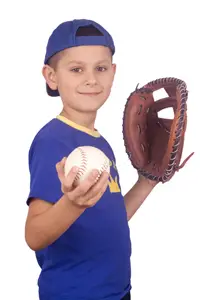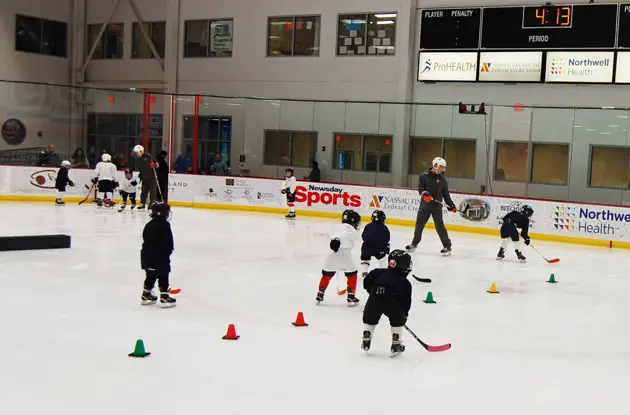As the weather warms up, it’s time for your kids to do the same. It’s the season for baseball, softball, soccer, and lacrosse. Like other sports, spring sports require athletes to execute multiple skills and techniques.

All athletes need to be able to move in the most effective ways so they can perform the skills that apply to their sport. To do so, they must experience how their bodies should react while executing sport-specific moves. Without this experience, they are at a distinct disadvantage on the field or court. For example, a young baseball player might be trained in the basics of fielding a ground ball but not know how to efficiently move to the ball from various directions.
Off-season at all levels is the time to improve an athlete’s seven fundamental skills: agility, balance, coordination, flexibility, speed, stamina and strength. These basic skills are often overlooked, but by incorporating movement training into your child’s lifestyle, you enable him to develop movements that will improve on his basic execution of sport-specific techniques, and thus on his overall performance. Collectively, the proper introduction and development of these athletic components give young athletes the foundation to achieve their potential in any sport they choose. They will find themselves able to execute important game-specific fundamentals such as throwing on the run (agility, balance, coordination); avoiding multiple defenders in lacrosse or soccer (agility, speed, coordination); bunting a baseball (agility, and coordination); maintaining possession after taking a hit in soccer or lacrosse (agility, balance); battling for a loose ball in soccer or lacrosse (strength, balance, coordination); or chasing a pass down the wing at the end of a soccer game (speed, stamina).
How do you get your child to develop these skills in a way that does not bore them? The key is to make it entertaining. Training should be implemented through fun drills and competitions that provide opportunities for self-testing and self-measurement of progression and success. Unique to this approach is that everyone can participate and be challenged in a non-stressful way. Athletes repeatedly practice to improve, measuring themselves against their own past performances. This is an approach commonly seen in sports such as skateboarding, surfing, snowboarding, and trick cycling.
The best place to try this is in the comfort of your backyard. Following are several suggestions of how to prepare your children in a fun, contemporary way for the upcoming spring season. Here the focus is on several of the essential athletic development skills; agility, speed, balance, and coordination.
AGILITY AND SPEED:
Agility is the core element that shapes all athletes. Athletes with agility tend to be speedy and flexible and possess a combination of mental quickness, alertness, and intelligence. Speed can be defined as the rate at which athletes move and also how quickly they react to a stimulus that causes a change in direction. The games of lacrosse and soccer require a great deal of change of direction through the execution of both agility and speed. In fact, agility and speed play a role in just about every interactive movement an athlete makes on a soccer or lacrosse field, whether with the ball, a teammate, an opponent, or all three at once.
Slalom Dash:
Downfield speed in its purest form is rarely a factor in most sports. More often athletes are faced with situations in which they must adjust while attempting to get from point A to point B as quickly possible. This slalom dash course simulates movements an athlete uses when pursuing an elusive opponent or when trying to beat an opponent to a particular spot on the field.
Equipment – Five cones, a stopwatch
Setup – Set up cone A as a starting line and cone B 10 yards up field from cone A. Place cone C five yards downfield from cone B (back toward the direction of cone A) and five yards to the left of cone B. Place cone D five yards back up field and five yards to the left of cone (C). Place the final cone E 10 yards downfield from cone D.
Execution – Athletes begin by running full speed from cone A to cone B, where they plant their right foot and dip their left shoulder around the right side of the cone before sprinting back downfield to cone C, where they plant their left foot and dip their right shoulder around the left side of the cone, and then sprint up field to cone D. At cone D, they plant their right foot and dip their left shoulder around the right side of the cone and sprint to the finish at cone E. After completing the course, athletes restart, this time running the drill in the opposite direction. There is no direct penalty for planting or dipping with the wrong foot or shoulder, but point out that proper execution of the drill will reduce their overall time.
Tip – Athletes most often make the mistake of dipping their hip when planting their foot to cut in a different direction. This type of body motion slows the athlete down by jamming the cutting foot into the ground. Athletes should be taught to extend the leg rather than dip the hip on the cutting side of the body, allowing the body to quickly move in the other direction.
Competition – Measure the competition by timing athletes as they complete the course. After they have recorded times for five executions, take the fastest time and use it as their base. Award one point for every second recorded under the athlete’s base time each time they run the course.
BALANCE:
Balance is the most essential skill for an athlete to possess, and requires time to develop. All sports rely heavily on balance. Think of a soccer player attempting to keep possession of a ball, a pitcher winding up and throwing to home plate, a basketball player taking a jump shot, a football lineman blocking a defender, or a tennis player playing serve and volley. In each case balance plays a key role in achieving the precise set of movements necessary for the skill to be performed correctly.
Balance Boarding:
This drill and competition improves upon balance in various situations such as aiding in recovering from off-balanced positions while executing sport fundamentals such as catching and throwing. Athletes develop equilibrium in motion through muscle memory. To develop balance, athletes must develop muscle memory in the sensory nerves through their lower limbs and the bottoms of their feet.
Equipment – A Vew-Do zone balance board (can be found and ordered on www.vewdo.com) or half foam roll.
Setup – Place the Vew-Do board or half roll on a semi-hard carpet or hard gymnastics mat. Be sure to use spotters to prevent athletes from falling and hurting themselves. Athletes should also wear protective helmets during this drill and competitions.
Execution – There are two progressions, beginning with a simple balance technique and followed by adding specific sport functions.
Progression 1 – Start the drill by placing the teeter fulcrum on the bottom of the Vew-Do zone board. If you don’t have access to a Vew-Do board, use a half foam roll (found in the fitness section of most sporting goods stores). Athletes attempt to maintain balance on the board while standing. Over time, once athletes become accustomed to balancing themselves, advance to the competition phase of the drill.
Competition – Record each athlete’s total amount of time spent balancing on the board over five attempts. For a total competition score, award one point for each second that athletes maintain their balance on the board (or roll) during all five attempts.
Progression 2 – Introduce athletes to balancing while focusing on executing other athletic skills simultaneously. Athletes stand on the board, as in Progression 1, and toss a baseball, basketball, football, or tennis ball to partners. Partners catch the ball and toss it back while balancing on the board. A variation of this drill for athletes 12 years old and older is to throw them a light medicine ball. This further tests their overall balance by having them react and adjust to the added weight while focusing on executing the catch and throw.
Competition – Record each athlete’s total amount of time balanced and total number of successful catches over five combined attempts. Award one point for each second that athletes maintain their balance on the board (or roll) and another point for each successful catch. Combine all five attempts for a total competition score.
COORDINATION
Some consider coordination an athlete’s most essential tool. Athletes might be incredibly fit and have great speed, stamina, strength, and flexibility, but without coordination they can’t execute the particulars of a sport. Since we are about to begin baseball and softball seasons, let’s look at an eye-hand contact coordination drill that relates to hitting/making contact.
Spot the Ball:
Athletes improve their overall eye–hand coordination, which is important for baseball, lacrosse, tennis, ice hockey, and many other sports. This drill is not intended to improve a baseball player’s hitting technique — only his eye–hand coordination. In this drill we’ll focus only on contacting the ball, which is probably the most important aspect of hitting. Note that this drill provides the athlete many swings of the bat, an ideal experiential exercise that allows the mind to focus on one aspect (locating and identifying the ball) without other thoughts interfering.
Equipment – 20 Wiffle balls, one plastic bat, 20 plastic golf balls
Setup – This drill requires a 10-yard by 10-yard area, preferably against a fence so that it’s easier to collect the balls.
Execution – Advance and challenge athletes to focus on the ball in order to make contact on a consistent basis.
Progression 1 – Each athlete begins with a plastic bat and a Wiffle ball. Using Wiffle balls eliminates any fear of being hit by a pitched ball and allows athletes to focus full attention on making contact. A partner stands about five yards away and pitches balls overhand. Begin with athletes attempting to hit the first 20 balls pitched. They should swing at all balls, regardless if they are in the strike zone. The more balls you have, the better this drill works; we recommend using at least 20 Wiffle balls, then progressing to small plastic golf balls.
Tip – Batters continue to swing at every ball thrown, but now they shout out, “Ball!” as soon as they locate the ball leaving the pitcher’s hand. This disciplines the athlete to locate the ball as early as possible and increases the success rate of hitting the ball. The key to improving eye–hand coordination is to locate and identify the ball as early as possible.
Competition – Count the number of balls hit out of 20. Tipped balls count as hits. Award one point for a tipped or foul ball and two points for all other solid contact. Record the total number of points for every 20 pitches; the maximum number of points that can be scored is 40 for every 20 pitches. Athletes self-measure and track their personal best.
SCOTT LANCASTER AND RADU TEODORESCU’s new book, Athletic Fitness for Kids (Human Kinetics, $15.95), enhances athletic skills for young athletes using a fun, self-directed system. SCOTT LANCASTER is the founder of Youth Evolution Sports; host of “ABCs of Sports”, a national youth sports show for parents and coaches on Sirius Satellite Radio, channel 123; and former NFL Senior Director of Youth Development. RADU TEODORESCU is a fitness trainer with gyms in New York City and Southampton. To learn more about their book and youth sports development training, visit www.youthevsports.com.





















